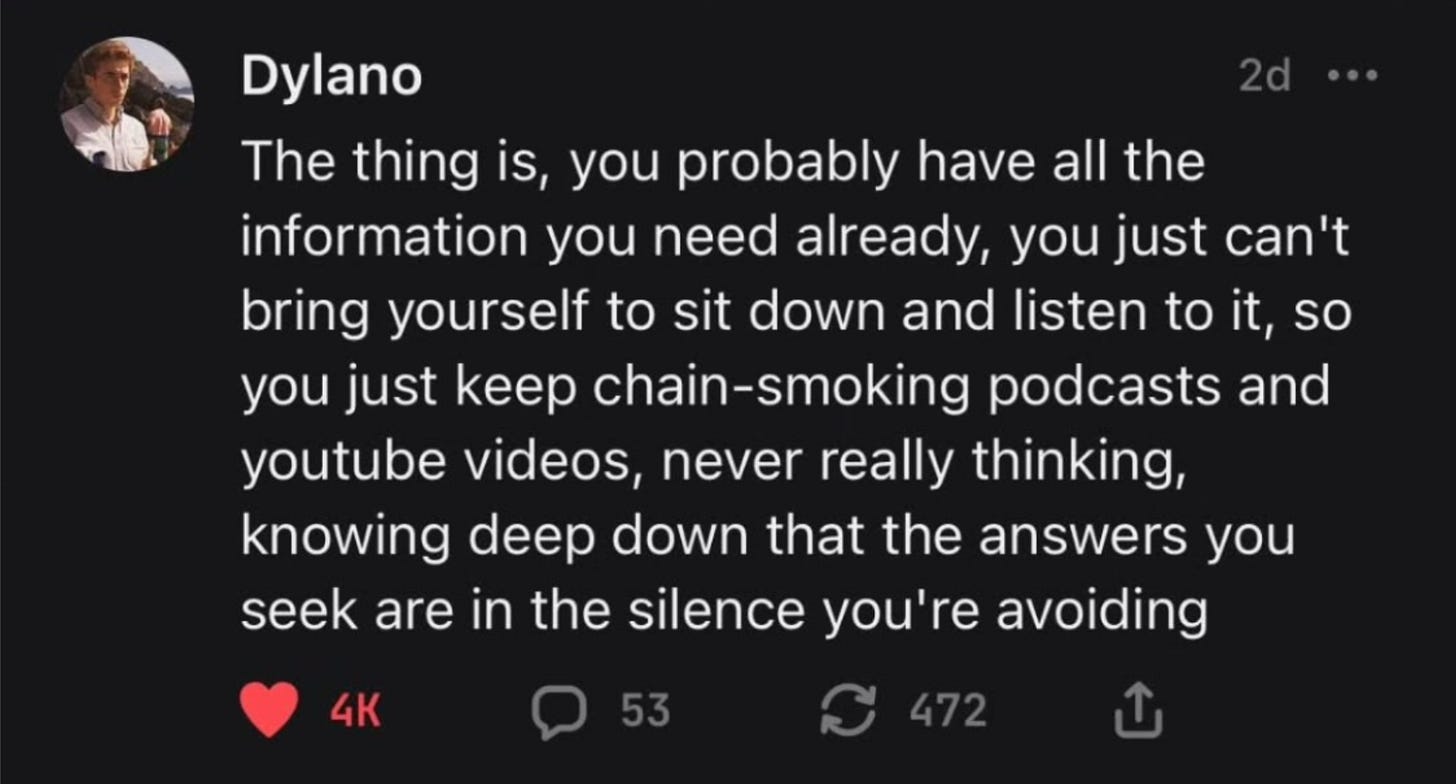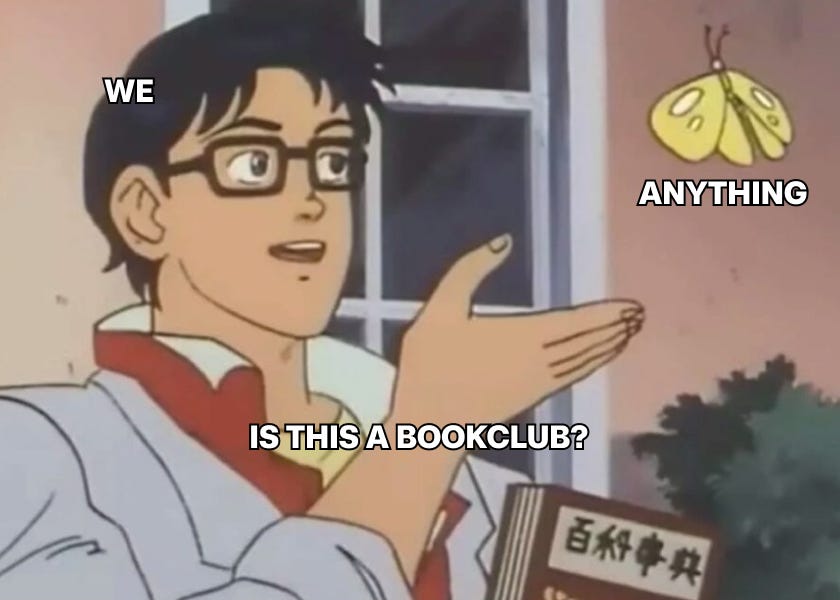How to Bookclub Anything
Or why gathering people is the easiest and best use of our communication skills.
Our last two issues focused on making sense of an increasingly algorithmically optimised world as creatives—how to work within it, push against it, and reclaim agency in the midst of it.
For this issue, we wanted to do something different. When communication has become more fragmented, transactional, and automated than ever, we wanted to return to its most human function: bringing people together. Not through marketing. Not through content. But through conversation.
That’s why we asked Bryan and Marc to write this issue. Their work doesn’t just analyse culture—it participates in it. They understand something we often forget in creative work: our most powerful communication tools aren’t decks or strategies or campaigns—they’re invitations. Posters. Group chats. Plans made in the park.
This piece is more than an essay—it’s a toolkit. A love letter to intentional gatherings. A practical guide that reminds us: you already have what you need. You don’t need permission. You don’t need a client brief. You just need a topic and the willingness to bring people together. And what better format for that than a bookclub?
See you at the Amsterdam bookclub on July 24th,
Helen x
Let’s not bury the lead; this is about using our communication skills to turn anything into a bookclub, and here’s how:
→ Pick anything you’re excited about
And we mean anything: a book, a tweet, a question, a piece of furniture, a movie.
→ Pick a date and place
It can be anywhere: a bar, a living room, a park, a community space, a bench.
→ Make a simple invitation
Use your communication skills! Design it, sketch it, 3D it, voice memo it, dance it.
→ Share it
Post it to ig, send it to groupchats, stick it on lampposts, add it to are.na.
→ Do it: bring people together
Whether you’re with three people or thirty; get together, talk, communicate!
→ Do it again!
Why keep it to an one-off?
Now, hopefully, you don’t feel like you need to read the rest of this. Hopefully you get the gist enough to get going. Because like any good sequel, this follow-up to our essay for Real Review aims to be “bolder, brighter, more accessible.” Simply said, we wanted it to be more actionable. Less reading, more doing. Less food for thought, more snackable steps to take. Which is why we opened with the conclusion. A real piece of communication. A series of posters designed by, and in conversation with, artist duo iida and ssi. Posters that not just broadcast but give you a chance to respond.
Imagine! You just saw something, felt something, questioned something. You’re itching to talk about it. Rather than firing up chat, socials or a podcast, you could actually gather people! You could bookclub it. You have the main essential: a topic. Done. Go. Bookclubs don’t require expertise, they don’t require production, they don’t even have to be original. The idea of bookclubbing itself isn’t either. We got it from Jared Zhang: “You can actually book club anything. You could have a book club but only for objects, you know. A book club that is not a book club at all, but it's fulfilling our needs of ingesting something and talking about it.”
To show how easy it is, we turned this idea into a bookclub too; July 24th, at post-office in Amsterdam. An open conversation about communication, a brainstorm on what to bookclub and a chance to connect with others to get started (we’ll put a small recap at the bottom once it’s over).
So far the how, now the why. Feel free to close the tab at this point and just start bookclubbing already. But for those curious, here’s a little extra caption. Call it an essay if you want. If we had more time, we would have written a shorter one.
Make communication communicate again
Everyday we’re drowning in a flood of messages aimed at our ever limiting attention spans. We’ll skip the statistics. We all feel it, we’re all sick of it. Yet, at this peak of communication, we’ve never felt more unheard, misunderstood or simply alone. No wonder when the majority of notifications, sponcon, ragebait, slop and brainrot don’t fit the description of what communication actually is: “an exchange of information.” A back and forth. A give and take.
Sure, we can comment, reshare, like and subscribe. But that’s just taking turns broadcasting at unequal scales. Even during facetime and group chats it’s hard to stay in the flow. To stay in that mode that is most beneficial of all: conversation.
Let’s namedrop a book in an essay about bookclubs, shall we? The Dawn of Everything is maybe not the first choice for a light-hearted group read but, if you ask us, it’s a pretty essential text. Especially if you’d like to break free from the “well, that’s just human nature” narratives that make us doom spiral today. One fact in particular always comes back to us. It’s about how we humans, on average, can only hold a single thought for about seven seconds at a time—except, when we talk to someone else. As Graeber and Wengrow write: “In conversation, we can hold thoughts and reflect on problems – sometimes for several hours on end.”
It’s one of those insights that never stops to amaze us while also feeling completely obvious. Of course conversation is when we’re most engaged. Especially IRL. The only moment when the give and take is almost impossible to ignore. Eye contact, body language, facial expressions, tone of voice—the dimensions of conversation go further than the richest media. This is communication that doesn’t just allow for an exchange, but demands one. It begs us to respond. To empathize. To disagree. To evolve our own thinking. To realize another’s perspective. At least when done in good faith. It’s not guaranteed to always go that way, but we’d argue it has a higher degree of likelihood than any other mode.
The downside is that you have to commute to most IRL conversations. But this too is a feature and not a bug. It offers time to anticipate the exchange. To think about what’s to come (even if it’s only seven seconds at a time). To enter the right mindset, to consider what we want to say and prepare for what we might hear in return. Wouldn’t it be nice to wander and wonder again, rather than the constant whiplash of jumping from video call to video call? To not context switch like crazy, or worse; hold several conversations at once split between camera, voice and text.
But one conversation at a time, in this attention economy? That would take a lot of convincing. Almost like a… seductive piece of communication. A call to action. Which is why it’s our challenge to overcome. Us, the supposed professional communicators. And if you suddenly feel overwhelmed at the thought of applying our daily skills to something so daunting as gathering people—then, join the club. The bookclub that is.
Bookclubs everywhere for those with eyes to see
We won’t deny it can be intimidating to set up an event. To try and get people to physically show up in 2025. But it’s not rocket science. And by framing it as a bookclub you don’t just lower the barrier to entry, but also to hosting. It’s not a panel. Not a talk. No one has to present. You don’t have to prepare (much). It’s just a bookclub. All you need is a topic, a place, a poster and a willingness to show up.
And it truly can be about a-n-y-t-h-i-n-g. Cassette bookclubs, html clubs critting bookclubs, short-attention-span bookclubs, queercoding bookclubs, snailmail bookclubs, jaded bookclubs, sonic bookclubs, deep listening bookclubs. Ok yes, those last few are basically … clubs. But that’s the point. There are bookclubs everywhere for those with eyes to see. And they can be anywhere too, whether a bar or a living room. It’s merely a way to frame a gathering, and a reason to make a poster.
It’s why it’s such a great canvas for us communicators: Bookclubbing brings us back to basics: making a single visual. A flyer. A reminder that not everything needs to be for clients or even client ready. Instead communication can, and should, open up a channel. A two way street. One that doesn’t need a high turnout to succeed. Five in a park, two at a kitchen table. It’s a bookclub. A loose and forgiving structure. A form to shape and space for conversation. And it just so happens to let us practice a “collective cultural immune response” to all that other noisy “communication” in the world: “To have enough solidarity between people, to sit in rooms together, make eye contact, have conversations and not feel so threatened that they can't tolerate one another.”
So let's start bookclubbing. Let’s design an invite. Let's make posters with friends. Let's gather. Together. What else is communication for? And we promise, it will get closer to creating a sense of community than any client brief ever can (unless, maybe, they’re open to being bookclubbed themselves).
Add your bookclub to the are.na channel.
Bryan Wolff is a writer, thinker and sometimes Creative Director, attempting to narrate urgent new complexities. Basically, wondering how do we want live today for the futures we need tomorrow? He’s the co-founder of post-office, director of creative at APOSSIBLE and has freelanced for agencies, brands and institutions.
Marc Vermeeren is a creative and strategic partner to brands, agencies, founders and other entities. For the past 20 years, most of the time as a creative director and designer, he has worked across brand, marketing and design with teams at A24, Airbnb, Calvin Klein, Coinbase, Raf Simons, SPACE10 and WeTransfer.
Thanks for reading. As The GOODStack develops, we will bring thought pieces from a great selection of voices and writers. We’re also eager to hear your ideas and suggestions to help shape The GOODStack into a resource that truly resonates with and benefits our community. Keep in touch!
The GOODStack’s initial curation is led by Helen Job. Helen has more than 20 years of experience in futures and cultural research, working both in-house and at agencies of various sizes. Formerly the Head of Research at SPACE10, Helen now leads her own creative ecosystem, Neu Futur, centred on deep research and preferable futures.







